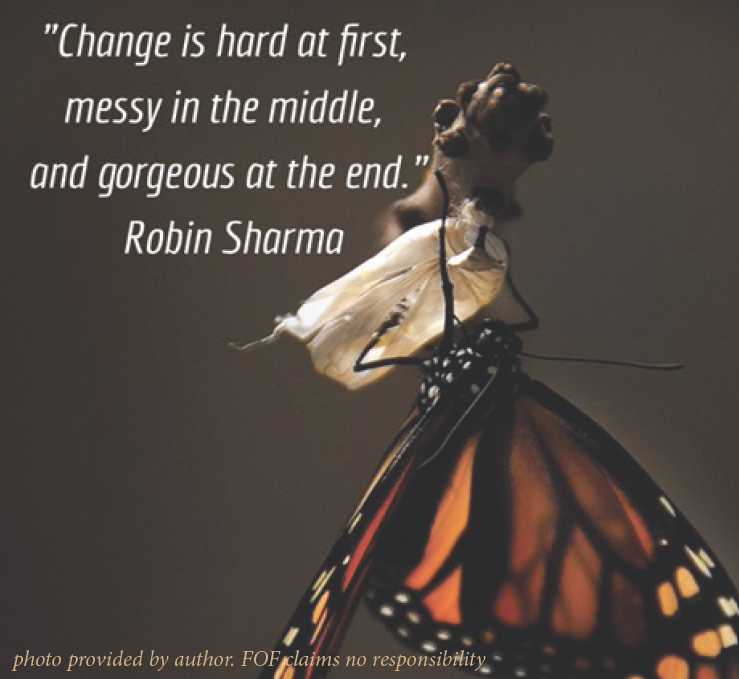“The secret of change is to focus all of your energy, not on fighting the old, but on building the new.” — Socrates
Countless times in my life, I’ve been in relationships, jobs, and even logistical locations I called home that had me depressed, frustrated, and feeling claustrophobic. Can you identify? Do you viscerally feel your own pains reading that line? One of the most ridiculous anxieties I had along with my co-workers was the implementation of electronic medical records and documentation. We fought it tooth and nail. How ridiculous now, right?
That feeling that if I my job changed to computer documentation, if I lived with that person one more day, their hurtful words and emotional abuse would obliterate whatever heart I had left. That feeling that if I stepped into that work setting one more day, the toxic environment would completely choke my desire to heal people how I once loved to do. That feeling that if I woke up in the same town one more day, the boundaries would turn into solid glass walls holding me hostage to a life I didn’t want — forever. Change was needed for growth.
Change is inevitable. The pain of staying in a situation you no longer want becomes greater than the pain of making a move. The back-and-forth between pros-and-cons start. Why is it so hard? If life is so bad, changing should be easy, right? What in the world could possibly be holding you back? Everything starts with the brain.
“Your life does not get better by chance, it gets better by change.” — Jim Rohn
Stronger than steel neural pathways created in childhood hold us back. From the time we’re born until around age 7, we create pathways or connections between our neurons which begin to determine our habits, hangups, and history. We create neural connections based on emotional experiences and repetition which results neurotransmitters released as the result of the experience.
Repeating the same actions, experiencing the same emotions, then repeating again we create connections stronger than steel by the time we’re 7 when the process begins to slow down. By then we are hooked. We have solidified a neural pathway which continues to strengthen unless at some time in the future, we make a conscious and daunting effort to lay a new pathway. We can never erase an old pathway, only detour around it.
“One reason people resist change is because they focus on what they have to give up instead of what they have to gain.” — Rick Godwin
Obsession to oxytocin hold us back. We finally make a conscious decision to make a change, and our brain sends a signal this isn’t normal. Especially if the decision involves moving, changing jobs, or leaving a relationship, the brain wants to avoid this impending drop in oxytocin, our neurotransmitter which makes us feel safe, included, and loved. Any threat to this neurotransmitter obviously feels like a threat to our life, love, and comfort. Therefore, we avoid a drop in oxytocin like the plague.
“May your choices reflect your hopes, not your fears.” — Nelson Mandela
Controlling cortisol hold us back. Along with the drop in oxytocin, a spike in cortisol often occurs when we attempt to make a change. Cortisol is our fight-or-flight and stress neurotransmitter.
Making a potential shift in behavior spikes cortisol as this is deviating from our strong neural pathways. Fight-or-flight kicks in, and we avoid change even if it’s in our very best interest! Too much cortisol in our brains can ultimately damage our brain’s function, but we do need a certain amount of cortisol balanced with stability in our lives.
“Change your thoughts, and you can change your world.” — Norman Vincent Peale
The key is aligning yourself to know when to stay stationary because life isn’t so bad, and we possibly learning other strategies to handle challenge, anxiety, and stress could create a better life. Align yourself to know when a move is necessary, and learn strategies to handle creating new neural pathways, reducing stress, and remaining calm so that change will be rewarding, not regretful.
So how do you know when to keep using those stronger than steel neural pathways and when to create a detour towards what you believe to be your destiny? You must align your thoughts, words, and actions with your true self. You must ignore what others think is right for you, and you must stay on the track of good feeling vibes. If it doesn’t feel right, it probably isn’t. If it feels good, test the heck out of it. It’s your choice. It’s always your choice, your decision, and your life. You must learn how to connect with your soul, and dominate your brain to design your life. Everything starts with the brain.
As an EI Expert, Certified Brain Health, and Certified Life Coach, I am a consultant to healthcare and educational leaders, law enforcement – the helpers of our world. Through my unique yet simple Emotional Intelligence strategies, leaders and staff learn to direct their thoughts, words, and actions for effective communication, improved situational outcomes, employee/client retention, and burnout prevention. Email: carrie@thebraindiva.com


